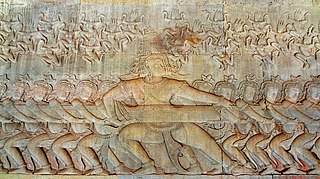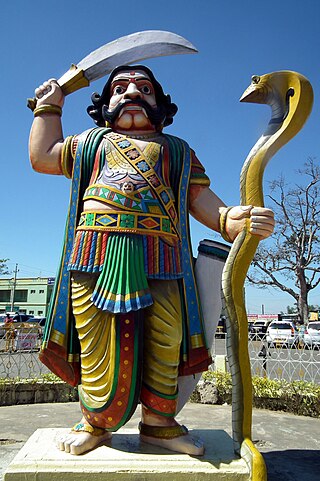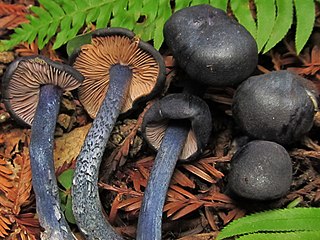
Asuras are a class of beings in Indian religions. They are described as power-seeking demons related to the more benevolent Devas in Hinduism. In its Buddhist context, the word is translated as "titan", "demigod", or "antigod".

Deva means "shiny", "exalted", "heavenly being", "divine being", "anything of excellence", and is also one of the Sanskrit terms used to indicate a deity in Hinduism. Deva is a masculine term; the feminine equivalent is Devi. The word is a cognate with Latin deus ("god") and Greek Zeus.

Mahishasura is a bovine asura in Hinduism. He is depicted in Hindu literature as a deceitful demon who pursued his evil ways by shape-shifting. Mahishasura was the son of the asura Rambha and a she-buffalo named Mahisi. He was ultimately killed by the goddess Durga with her trishula (trident) after which she gained the epithet Mahishasuramardini. Mahishasura had a son named Gajasura.

The Samudra Manthana is a major episode in Hinduism that is elaborated in the Vishnu Purana, a major text of Hinduism. The Samudra Manthana explains the origin of the elixir of eternal life, amrita.

An asura in Buddhism is a demigod or titan of the Kāmadhātu. They are described as having three heads with three faces each and either four or six arms.

In Hindu cosmology, the Kshira Sagara or Ocean of Milk is the fifth from the centre of the seven oceans. It surrounds the continent known as Krauncha. According to Hindu scriptures, the devas and asuras worked together for a millennium to churn this ocean in order to acquire amrita, the elixir of immortal life. The episode is mentioned in the Samudra Manthana chapter of the Puranas, a body of ancient Hindu legends. The Kshira Sagara is described as the place where the deity Vishnu reclines over his serpent-mount Shesha, accompanied by his consort, Lakshmi.

Asura is a genus of moths in the subfamily Arctiinae, and subtribe Nudariina erected by Francis Walker in 1854.

Ipomoea carnea, the pink morning glory, is a species of morning glory that grows as a bush. This flowering plant has heart-shaped leaves that are a rich green and 6–9 inches (15–23 cm) long. It can be easily grown from seeds. These seeds are toxic and it can be hazardous to cattle; the toxicity is related to the swainsonine produced by its endophytes, and to bioaccumulation of selenium in the leaves but mostly in the seeds.

Oreta is a genus of moths belonging to the subfamily Drepaninae. The genus was erected by Francis Walker in 1855.

Pseudosimnia carnea, common name the dwarf red egg shell, is a species of sea snail, a marine gastropod mollusk in the family Ovulidae, the ovulids, cowry allies or false cowries.
Onchidiopsis carnea is a species of small sea snail with a transparent internal shell, a marine gastropod mollusk in the family Velutinidae. Because the shell is mostly internal, the snail resembles a sea slug in general appearance.

Chrysoperla carnea, one of the species of common green lacewing, is an insect in the Chrysopidae family. Although the adults feed on nectar, pollen and aphid honeydew, the larvae are active predators and feed on aphids and other small insects. It has been used in the biological control of insect pests on crops.
Asura quadrilineata is a moth of the family Erebidae. It is found on Aru and in Australia.

Cyme sexualis is a moth of the subfamily Arctiinae first described by Felder in 1864. It is found on Ambon, Sulawesi, the Dampier Archipelago. and in New Guinea.

Mammillaria carnea is a species of cactus in the subfamily Cactoideae.
Oreta carnea is a moth in the family Drepanidae. It was described by Arthur Gardiner Butler in 1892. It is found in Malaysia, Singapore and on Sumatra, Java and Borneo.
Garrha carnea is a moth in the family Oecophoridae. It was described by Philipp Christoph Zeller in 1855. It is found in Australia, where it has been recorded from Queensland, New South Wales, Victoria, Tasmania and South Australia.

Entoloma subcarneum, commonly known as the indigo leptonia, is a mushroom native to the Pacific Northwest of the United States, belonging to sub-genus Leptonia of genus Entoloma. It is 30–65 mm broad.
Susna is an asura described in Hindu texts. Normally associated with drought, Susna is often described as possessing a snake-like form with horns. He is an enemy of the deity Indra.













